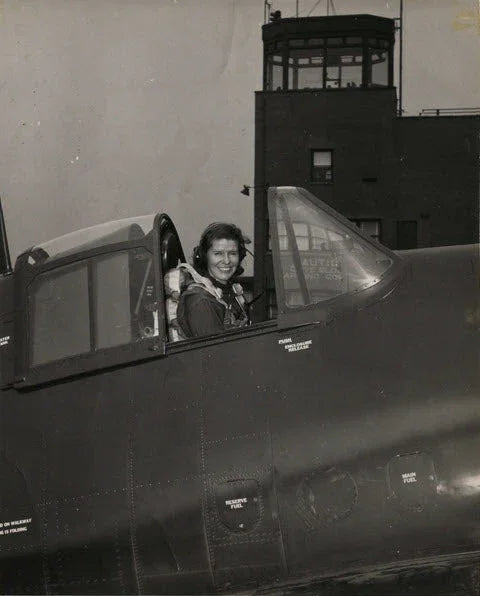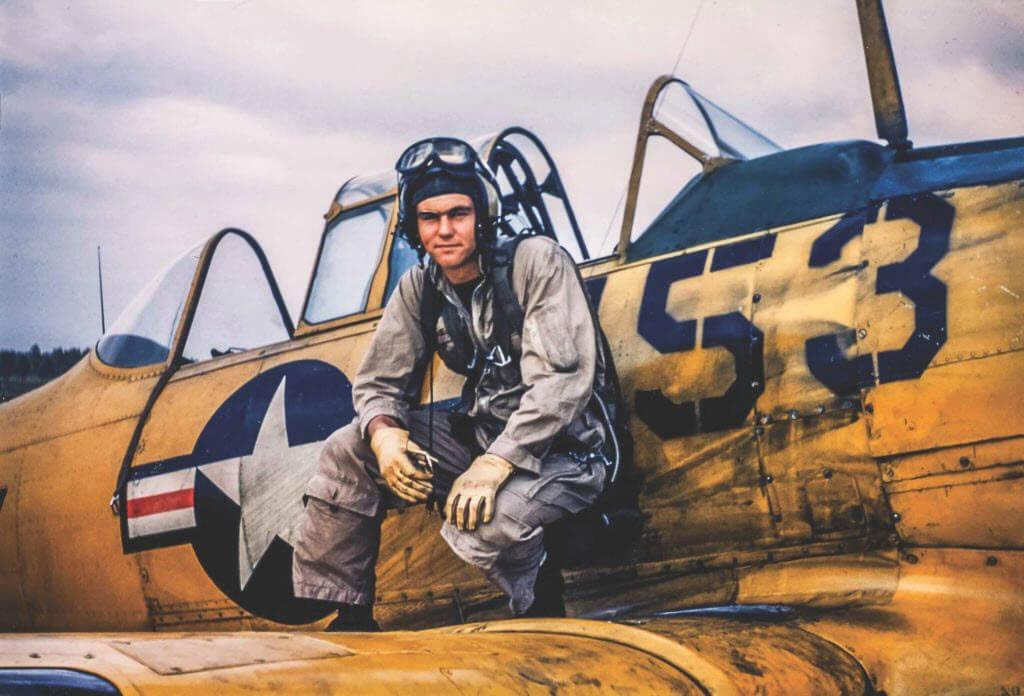"Butch" O'Hare: The Original Top Gun
In my last post, I talked about my past and my relationship with my father. His kindness and encouragement led me to become a pilot.
My flying career started as a CFI (Certified Flight Instructor), then charter pilot, then corporate pilot, and eventually as an entrepreneur forming an insurance agency and now selling aviator sunglasses.
Today I want to talk about a very unusual pilot, "Butch" O'Hare.
The Apple Doesn't Fall Far From The Tree - Or Does It?
Edward "E.J." O'Hare, the father of "Butch" O'Hare, was quite an interesting fella.
Born September 5, 1893, to first-generation Irish-American parents in St. Louis, MO, "E.J." fathered three children with his wife Selma Anna Lauth of St. Louis.
The three children were Edward "Butch" O'Hare, Patricia O'Hare and Marilyn O'Hare.
At the age of 30 "E.J." became a lawyer and passed the Missouri bar exam, then joined a law firm.
But "E.J." was ambitious, loved dog racing, and operated a dog racing track in St. Louis with his client, Owen P. Smith, the high commissioner of the International Greyhound Association.
Smith invented and patented the mechanical running rabbit for use in dog racing.
During this time period, "E.J." began flying as an air mail route pilot, and later flew commercially whenever he could.
This gave "E.J." the opportunity to introduce young "Butch" to flying and let him take the flight controls from time to time.
When Smith died "E.J." was the administrator of his estate and expanded the business from St. Louis to Chicago.
"E.J." and his wife divorced in 1927 and he moved to Chicago while his son "Butch" was sent to Western Military Academy.
In Chicago, "E.J." met Al Capone with whom he collaborated in the business of operating dog tracks in Chicago, Boston, and Miami. He then became known as "Easy Eddie".
In 1930 it is believed that "Easy Eddie" O'Hare decided to rat out Capone by setting up a meeting with the IRS and played a key role in Capone's prosecution and conviction. After the Valentine's Day massacre in 1929 "Easy Eddie" became tired of working with thugs.
He told the prosecutors that Capone fixed the jury, so the judge switched juries just before the trial began.
It is alleged that "Easy Eddie" did NOT want his son to follow in his footsteps.
On November 8, 1939, O'Hare's past caught up with him and he was killed by two shotgun-wielding gunmen.
"Butch" O'Hare goes to the Naval Academy
After 5 years at Western Military Academy "Butch" applied to the Naval Academy, and succeeded in begin accepted in 1932.
In 1937 he graduated from Annapolis, graduating 255th of 323 in the class.
On the day of "E.J."s death Ensign Butch O'Hare had made two training flights a the Naval Air Station in Pensacola, Florida. When he landed at sunset he was told of his father's death.
In May of 1940, he graduated and was presented with the gold naval aviator wings.
From there O'Hare went on to train with an air combat squadron where he learned aerial combat and night carrier landings.
Butch was an accomplished marksman and excelled in aerial gunnery.
In July of 1941, he took a break from training and was ferrying F4F-3 fighters. He picked one up from Floyd Bennet Field in Brooklyn and flew to St. Louis to visit his mother.
During that visit, he met a nurse by the name of Rita Wooster, and he asked her to marry him. She told Butch she didn't love him because she had just met him, but Butch didn't care.
She then told him she was a Catholic and would only marry a Catholic, so Butch converted, and six weeks later they were married.
Immediately after the wedding, Butch had to report for duty with his squadron aboard the USS Saratoga aircraft carrier.
The squadron flew Grumman Wildcats, the Grumman F4F-3. This what the aircraft was like to fly:
Sunday, December 7, 1941 - Pearl Harbor
Butch was off duty that day and heard about the Japanese attack on his way home from lunch with his wife Rita.
The next day the USS Saratoga was dispatched to Pearl Harbor.
In January of 1942, Butch's squadron was moved to the aircraft carrier the USS Lexington which was part of a task force ordered to sail across the equator into the South Pacific and attack the Japs.
At about the same time the Japanese landed at Rabaul, which was a few hundred miles north-northeast of Australia.
The commander of the task force, Vice Admiral Wilson Brown, quickly realized the US Navy was now in uncharted waters and had to rely on navigation information garnered by the British Royal Navy a century earlier!
Brown sailed his task force towards Rabaul where the Japanese had 18 land-based bombers called "Bettys" by the Americans because of their shape.
(It is said that the real Betty was a voluptuous American Army nurse.)
On February 20th, around 2 pm in the afternoon 17 of these Bettys took off to attack Wilson's task force in two waves.
Luckily, an American submarine spotted them and radioed the task force.
All nine Bettys in the first wave were shot down by Lexington's Grumman F4F Wildcat fighters and anti-aircraft batteries.
Butch and his wingman, Duff Dufilho, were launched from the carrier and as they climbed out to altitude the combat information center radioed them and told them the remaining eight Bettys were approaching the Lexington.
Butch and Duff quickly realized that they were the only aircraft positioned to attack the Japanese formation.
They charged their machine guns and fired test burts to make sure they were working properly. Duff's four guns jammed, but Butch's worked just fine!
The Japanese Bettys were in a V formation and about three minutes from the USS Lexington, so Butch flew past the lead Betty and attacked the last two on the right with machine gun fire.
His time on the gunnery range paid off as both Bettys dropped out of the flight.
At the same time the sky above the Lexington was filled with anti-aircraft fire, but knowing that he was defending his carrier Butch dove into the formation and shot down three more Bettys.
Landing back on the USS Lexington shortly after 5:45 pm he had shot down five Japanese Betty bombers in under four minutes.
The USS Lexington's commander, Captain Frederick Sherman, recommended Butch receive a decoration for his bravery.
But, it was too late. By March 4th his heroism was front page news everywhere in the US.
Up until this time, there was scant good news coming from the war effort. FDR felt the US needed a hero, and Butch fit the bill.
At 10:45 am on April 21, 1942, Butch and his wife Rita entered FDR's office where the President promoted Butch to Lt. Commander and awarded him the Congressional Medal of Honor!
By early June 1942, Butch took command of his old squadron as the fleet celebrated the victory at Midway Island.
Butch enjoyed a peaceful interlude from the war commanding a new squadron flying the new Grumman F6F Hellcats until August of 1943.
Butch was promoted an Air Group Commander overseeing three squadrons of F6F Hellcats.
By November 1943, his air group was assigned to the USS Enterprise which joined a large task force heading for the Gilbert Islands southwest of Hawaii.
Beginning on November 19th, Buth's air group supported the assault on Makin Island.
The Japanese changed their tactics to fly Bettys on low-level attacks at dusk and were successful in putting a torpedo into the USS Independence.
Butch was asked to come up with a defense against these dusk attacks.
He created three aircraft teams, two F6F Hellcats plus an Avenger torpedo bomber outfitted with radar. These night fighter teams were called "Black Panthers."
On November 26th, 1943, the USS Enterprise's combat information center alerted Butch to a group of around 20 inbound Bettys.
As night fell Butch, his wingman Andy Skon launched but the Avenger flown by Lt. Commander Phillips was not yet launched when the USS Enterprise's fighter-direction officer abandoned Buth O'Hare's "Black Panther" plan.
Instead, Butch and his wingman were sent on a search for the low-flying Bettys.
After an hour of searching, they decided to find Phillips' Avenger. As Butch approached the Avenger Butch asked Phillips to turn on his "turtleback" light, a white light just behind the pilot's headrest.
Butch turned his "turtleback" light on as well and he and Skon slid in behind the Avenger.
The rear gunner in the Avenger, Alvin Kernan, noticed a fourth aircraft appear above and behind Butch. Phillips radioed Butch and told him there was a Jap on his tail, and ordered Kernan to fire on the Jap plane.
But the Jap plane fired first from its nose down into Butch's Hellcat.
Shortly thereafter Skon and the Avenger's crew something appear below splashing into the sea.
On December 9th the Navy announced that Butch was missing in action.
After an extensive but unsuccessful search for Butch, the search was abandoned.
On December 20, 1943, a Mass of Requiem was held for Butch at the St. Louis Cathedral.
Chicago's O'Hare Airport

After the war, on April 19, 1947, Col. Robert R. McCormick, the publisher of the Chicago Tribune, proposed that Chicago's new airport be named for Butch O'Hare.
The next week, on April 26th, Collier's magazine published the story of the best undercover man IRS Agent Wilson had ever known: Eddie O'Hare!
Butch never lived in Chicago but had visited his father "Easy Eddie" many times.
On September 17th, 1949, O'Hare Field was dedicated to EJs son, Edward H. "Butch" O'Hare.
O'Hare International Airport claims its namesake as "a World War II fighter pilot from Chicago", even though Butch never lived there.
Chicago continues to claim Butch as their own, to this day.
It ain't true!
Visit our store for a great deal on aviator sunglasses!
In the meantime, keep your eyes safe and focused on what's ahead of you Hersch!


ps:
I have visited O'Hare International Airport many times, sometimes when I flew an aircraft into O'Hare, and other times when I was simply a passenger passing through O'Hare.
O'Hare is the 4th busiest airport in the US, but in terms of physical land size, it is the 7th largest airport in the US. However, O'Hare is not even in the top 10 largest airports in the world.





Leave a comment
This site is protected by hCaptcha and the hCaptcha Privacy Policy and Terms of Service apply.